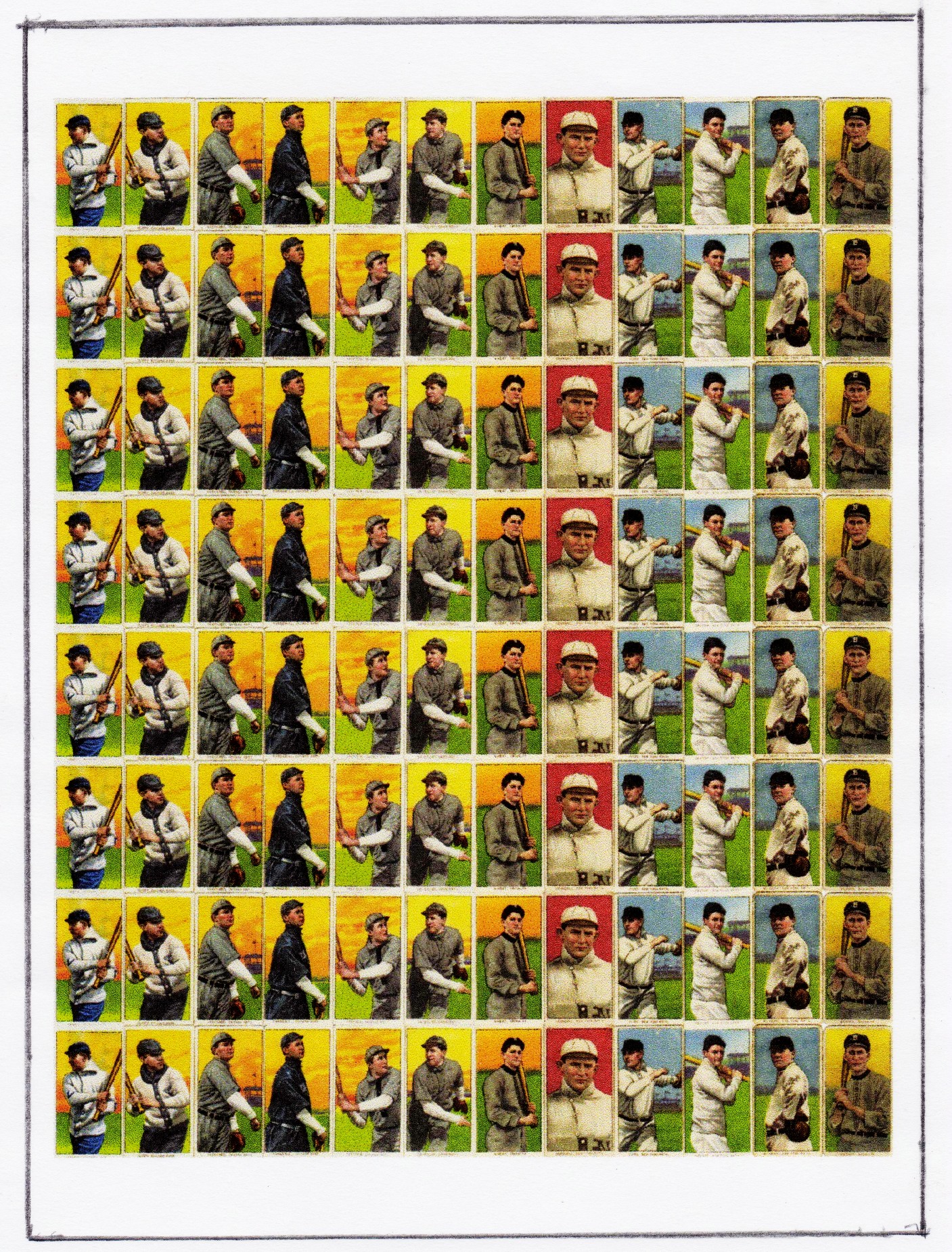Quote:
Originally Posted by tedzan

Shown here is my concept of a 96-card press run of T206's printed on a standard 19" x 24" sheet **. For illustration, I depict the 12 subjects in the 460-only series, of
which I refer to as the "Exclusive 12". For more info on these 12 cards, check-out this thread..... http://www.net54baseball.com/showthread.php?t=163949
Assuming the printing of these cards was centered as depicted on this sheet, then the side borders are is 7/8" each. And, the top and bottom borders are 1 1/2" each.
...... V................................................. .................................................. ....................... 19 inches .................................................. .................................................. ......................V
 **
** Note this standard sheet size was provided by Steve B. The 19" width is consistent with early 20th Century lithographic printing presses. The length of the sheet
can be a variable, depending on the number of cards being printed..
TED Z |
For those cards that's an entirely plausible sheet.
But it's also a nice example of cross-brand complexity.
When the pop report numbers are looked at some interesting things come up
A couple notes first
There are obvious known problems with population report numbers. Crossovers, crack and resubmit, both skew the numbers. For now they're the best numbers we have.
HOF or high demand players/poses typically run about double the population of commons. That seems to hold true across ALL T206s, and maybe other sets too.
The McGraw numbers are even less exact than usual for pop report numbers. Many were done without noting the pose so I had to adjust the numbers for by splitting the unknown poses by the ratio for the brand.
And - the McGraw missing from cycle 460 is no error, apparently SGC hasn't handled one. It is a verified card though. (Congrats to whoever has it, it appear to be a really tough one.
SC Pied Sov AB Cycle
Devore 38 68 12 12 1
Duffy 75 115 26 13 5
Ford 41 54 37 11 5
Gandil 76 89 25 6 2
Hummell 48 67 16 6 2
McGraw 66* 113 20 3
Pfeffer 40 65 14 6 4
Tannehill 43 67 40 4 2
Wheat 77 126 19 6 2
Crandall 54 70 23 11 1
Geyer 53 65 21 7 3
Sheckard 50 81 18 12 2
Looking at these numbers things stay ok with Piedmont and SC. The players expected are not quite double the commons, and there are no surprises - All the Piedmonts are more common than the SCs. (SGC doesn't show factories, something I'd love to see done. )
Sovereign we start to see "problems" Most are in the mid teens to low 20's in population. Except Tannehill and Ford at 40 and 37. And the players I'd expect to be in that range aren't. There could be a few reasons for that. Maybe more Sov 460 HOFers were graded before SGC, so the numbers are skewed. That's still not really explaining why Ford and Tannehill are so common. Both very nearly as common as the SC version.
Moving on to AB I'd expect to see the same pattern. That's generally true, except Tannehill is one of the toughest. And three other commons seem to be "too common" And ALL the higher demand cards are tougher.
Cycles appear to get back to a more normal pattern. But except Duffy the higher demand cards still seem underpopulated. Especially McGraw.
The different patterns make me think the sheet layouts were different for the less popular brands. The Superprints aren't a good fit as potential sheet mates on A Sovereign sheet, are almost entirely excluded for AB - The popreport shows a single Chase. I think that's probably a mistake. They barely fit with Cycle. but would require an unbalanced sheet, for instance one or two superprints replacing cards in the column of 8
The sample size for Cycle is probably too small for the numbers to have much meaning.
The possibility is still there that a lot of the Sov, AB, Cycle high demand cards were graded before SGC came along, which would make the numbers more sensible.
PSA doesn't indicate the series, and I haven't run the PSA numbers for these 460 only cards.
I've done some of the 150 series, and none of the 350's the 150's seem remarkably consistent, aside from the rarities there are only one or two odd looking numbers.
Steve B